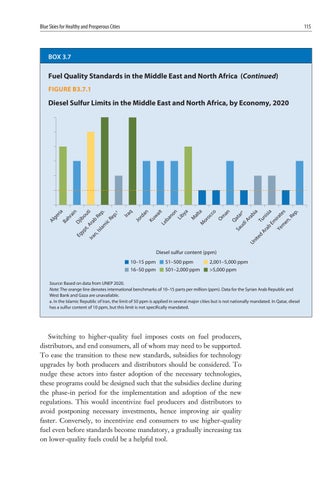Blue Skies for Healthy and Prosperous Cities
115
BOX 3.7
Fuel Quality Standards in the Middle East and North Africa (Continued) FIGURE B3.7.1
. ep
s
,R en
d
Ye
m
ira
te
sia Ar
Sa
ab
Em
ni
Tu
bi
a
ra
ra
ta
iA
an
ud
Qa
co oc
or
Om
ta al M
M
no n Lib ya
t ai
ba Le
w
an
Ku
rd
q
Jo
Ira
p. a Re
ic am
Isl n,
Un
ite
Ira
Eg
yp
t,
Ar
ab
Re
p.
ti
n
ou
ai
ib Dj
hr Ba
Al
ge
ria
Diesel Sulfur Limits in the Middle East and North Africa, by Economy, 2020
Diesel sulfur content (ppm) 10–15 ppm 16–50 ppm
51–500 ppm 501–2,000 ppm
2,001–5,000 ppm >5,000 ppm
Source: Based on data from UNEP 2020. Note: The orange line denotes international benchmarks of 10–15 parts per million (ppm). Data for the Syrian Arab Republic and West Bank and Gaza are unavailable. a. In the Islamic Republic of Iran, the limit of 50 ppm is applied in several major cities but is not nationally mandated. In Qatar, diesel has a sulfur content of 10 ppm, but this limit is not specifically mandated.
Switching to higher-quality fuel imposes costs on fuel producers, distributors, and end consumers, all of whom may need to be supported. To ease the transition to these new standards, subsidies for technology upgrades by both producers and distributors should be considered. To nudge these actors into faster adoption of the necessary technologies, these programs could be designed such that the subsidies decline during the phase-in period for the implementation and adoption of the new regulations. This would incentivize fuel producers and distributors to avoid postponing necessary investments, hence improving air quality faster. Conversely, to incentivize end consumers to use higher-quality fuel even before standards become mandatory, a gradually increasing tax on lower-quality fuels could be a helpful tool.






